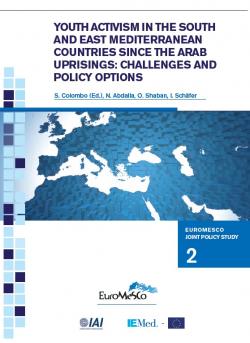Youth Activism in the South and East Mediterranean Countries since the Arab Uprisings: Challenges and Policy Options
Dealing with the youth in the MENA region entails acknowledging that this is a diverse category. Young people across different social, cultural, class, gender and ethnic strata have expressed a number of socio-economic needs and demands and have tended to act differently. The experiences of the individual South and East Mediterranean countries also tend to differ to a great extent as far as the governments’ response and policies are concerned. The first part of this study offers a background analysis to understand this complexity and the different claims, forms and strategies of activism around socio-economic issues. The following chapters analyse the Egyptian and the Palestinian experiences respectively, highlighting thereby specific aspects of youth activism in the SEM region. The final contribution, with a focus on Tunisia, analyses the potential contribution of EU’s policies in fostering a youth-sensitive approach.
Outcome of the Working Package on "Youth Activism in the South and East Mediterranean Countries since the Arab Uprisings: Challenges and Policy Options", led by the Istituto Affari Internazionali (IAI) in the framework of the EuroMeSCo project “Euro-Mediterranean Political Research and Dialogue for Inclusive Policy-Making Processes”.
-
Details
Barcelona, European Institute of the Mediterranean, February 2016, 74 p. (EuroMeSCo Joint Policy Study ; 2)
1. Youth Activism, Government Policies and the Role of the EU, Silvia Colombo, p. 7-24
Introduction
1.1 The Impact of Government Policies on Youth Exclusion/Inclusion
1.2 Framing Youth Activism in the South and East Mediterranean Countries
1.3 The EU’s Youth-Relevant Policies and Approach in the South and East Mediterranean Countries
1.4 Conclusions and Outline of the Other Chapters of the Policy Study
Bibliography
2. The Quest for Accountability and Socio-Political Change in Egypt: Repertoires of Actions and Challenges for Youth Activism at the Local Level, Nadine Abdalla, p. 27-43
Introduction
2.1 Advocacy and Training: A Way to Increase Youth Inclusion?
2.2 Creating and Supporting “Popular Committees”: A Way to Empower People?
2.3 Playing a Mediating Role: A Way to Build Local Lobbies and Social Capital?
2.4 Conclusions and Recommendations
Bibliography and Background references
3. The Arab Spring and the Palestinian Youth Movement: Different Challenges and Priorities, Omar Shaban, p. 45-59
Introduction
3.1 The Political Context
3.2 The Arab Spring: Palestinian Youth Hopes
3.3 A Palestinian Spring?
3.4 Palestinian Youth Actions and Forms of Mobilisation
3.5 An Extreme Form of Resistance. Neither Intifada, nor Military Resistance: the Habbah
3.6 “Arab Winter”, “Palestinian Winter”: Disillusion and Radicalisation?
3.7 Conclusions and Recommendations
Bibliography
4. Fostering a Youth-Sensitive Approach in the EU’s Policies towards the South and East Mediterranean Countries – The Case of Tunisia, Isabel Schäfer, p. 61-74
Introduction
4.1 Aspirations and Concerns of Tunisian Youth(s)
4.2 Fostering a Youth-Sensitive Approach in EU Policies
4.3 The EU’s Toolkit to Tackle Youth Challenges in the SEM Countries
Bibliography and Background references
Topic
Tag
Related content
-
Ricerca06/01/2014
Euro-Mediterranean Study Commission - EuroMeSCo
leggi tutto



